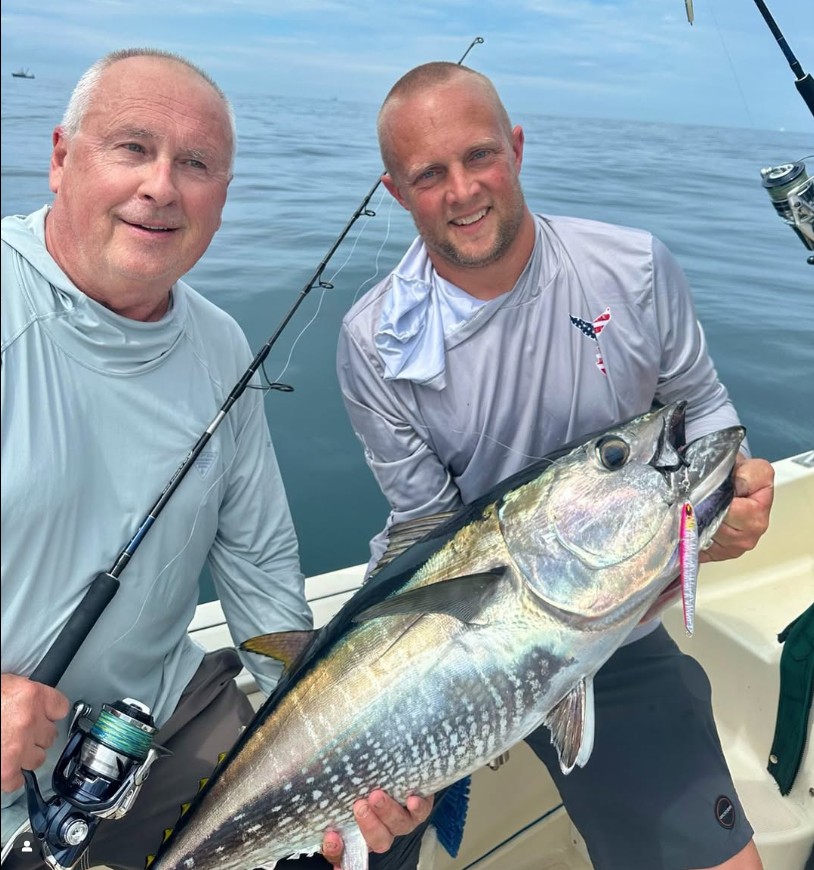It’s been over a week since NOAA closed the recreational bluefin tuna fishery, and captains and anglers who’d planned on tuna fishing through the fall are still adjusting to the regulations. The hardest hit by the closure were the charter captains, who had to notify clients, some of whom booked tuna trips a year in advance, that any bluefin they caught must be released.
“My clients were upset for sure,” said Captain Joe Diorio of Joe Diorio Guide Service. “Everyone loves eating fresh bluefin on the day they caught it.”
Captain Kevin Albohn of Blue Line Charters had three cancellations in the week following the regulation change. These cancellations, he said, came from new clients.
Most of my clients want to fight tuna and feel that burn,” said Diorio of his regular anglers booked in the days following August 12.
“My established customers just enjoy being on the water, and understand the importance of getting out and catching, tagging, and releasing fish, said Albohn. “We have tags onboard from NOAA and also DNA collection kits from the University of Maine and The Bluefin Collaborative. The data we help collect will help show that the bluefin stock is healthy and help prevent this from happening again in the future. I am lucky to have clients that want to participate.”
Captains were given less than a week notification of the pending change. In those days, they contacted clients booked after August 12 to notify them that any bluefin would need to be released and lay out their options, and how they can adjust the trip’s gameplan.

Some captains are ranging farther in hopes of finding yellowfin tuna that clients can still take home, but the added fuel burn nibbles away at the already tight margins of charter fishing. Plus, on southern New England’s midshore grounds at least, the yellowfin fishing has been inconsistent this season.
“Hey, if the yellows come in, I’ll target them,” says Diorio, “but if they don’t, we will play catch and release with the bluefin, and hope for a pallet filled with mahi and triggers to float by.”
“The most difficult part is we are coming into hurricane season so weather is a huge factor,” explains Albohn. “The yellowfin haven’t been close, so there is a huge time and fuel commitment on top of needing the right forecast. Bluefin catch and release can be combined easily with some mahi action for some fish to take home. Another option is the extended day trip to the canyons. And finally we can target giant bluefin on traditional rod and reel or, for my crazy clients, jig and pop gear specifically designed to target giant bluefins.”
Albohn explains, that even with all these options, the forecast is the ultimate decision maker and this time of year.
Overall, the sudden regulation change has put captains and charter operations in a tough spot. “Charter operations cannot cancel trips because the client does not want to go to the midshore “bluefin grounds” because they can’t keep a fish. This is where these midshore tuna trips derived from. This closure has stripped us of the foundation of our businesses.” Albohn says. The effects of this closure are already affecting the 2026 charter season: “My repeat clients have been asking about next year, if they should book earlier to avoid a closure for next season’s trip.”
The yellowfin could still swoop in and “save the season” for anglers looking to come home with tuna without going to the canyons. “Currently the blue water, perfect temperatures, mammals and bait are all in the area, along with bluefin. It is literally an “any day now” type of scenario for the yellowfin to arrive,” says Albohn. “But if we cancel the trips altogether, we won’t be there when the fish arrive.”
The bluefin tuna fishing on the midshore grounds from Southern New England to New Jersey has remained excellent since the regulation change (when the weather allows). The fishermen who went out to enjoy catching and releasing the bluefin found smaller fleets but plenty of hungry fish. If you have a trip booked for the remainder of this tuna season, hold those dates. If you haven’t booked one, keep an eye on social media as cancellations are providing rare last-minute opportunities to get out with some of the top captains in the fleet.
Tuna fishing, especially with jigging and popping tackle, is about so much more than the meat. The whole experience, from seeing the whales and dolphins, to the bite and the run, to that first glimpse of color as your arms start to burn makes it some of the most exciting fishing you can do anywhere in the world. I love the whole process of taking home bluefin, from the beers and music at the fillet table to fresh-as-it gets sashimi feast, but if that was what it was all about, I would save myself a lot of money and time by leaving the rods at home and heading right to the nearest sushi restaurant.
As anglers go out to responsibly catch and release bluefin this season, it’s important to remember that “landing” the fish is now prohibited, so fish must remain in the water, not pulled onto the boat. Long-handled dehookers make it easy to remove single hooks from trolling lures or jigs. A sturdy pair of pliers is usually needed for trebles on plugs, though anglers can make it easier on themselves and the fish by replacing the trebles on their tuna plugs with heavy-duty inline singles.
Also, report your catch at the end of the trip. Recreational anglers are one of the primary sources of data that fishery managers use to make decisions like the one leading to this closure. While it feels like NOAA let the Northeast tuna fishery down this year, providing them with catch data will help them assess the size of the tuna population, and, at least we’d hope, avoid sudden closures like this in the future.

